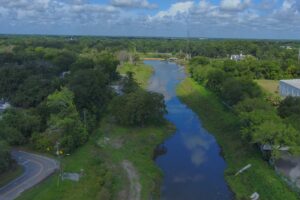The district provides new homes for scrub-jays
Intelligent and curious, scrub-jays are among the friendliest indigenous birds found in Florida. Unfortunately, these birds can only survive in rare oak scrub communities of Florida, a habitat preferred for development due to its dry, sandy terrain. The loss and fragmentation of scrub land has resulted in the decline in scrub-jay numbers.
Whenever possible, the St. Johns River Water Management District provides new homes for birds being displaced by land use changes. It’s something akin to a happy avian version of the U.S. Witness Protection Program.
“The scrub-jay is the Goldilocks of the scrub,” says Land Manager Maria Zondervan, who has led many scrub-jay relocations. “There can’t be too many pines, no more than two pines per acre. There must be enough oaks, but not too many. There must be sand, but not too much. Ideally, you want the scrub to measure between your hips and head. If it is too high, you have to burn it or cut it.”
Relocating jays is only part of the equation. Zondervan also captures the birds and attaches colored bands to their wiry legs for tracking and future identification. First, Zondervan must set a drop trap. The concept is primitive but effective: Prop up a wire cage with a stick, tie a long string to the stick, set peanuts or meal worms on the ground beneath the cage and tug the string when the jay enters the propped cage.
“We need to use several colors to ensure that we have enough unique combinations to differentiate the birds,” Zondervan says.





